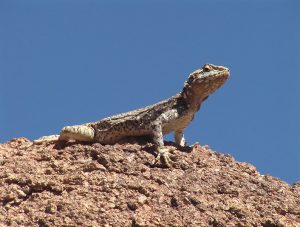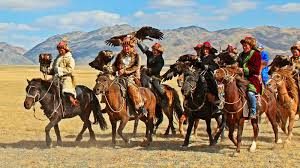In the Field with the Institute!
.
Dinosaur Expedition to the Gobi, Mongolia
May 22-June 4 (dates are now final)
.
Join legendary dinosaur paleontologist Michael Ryan, Curator of vertebrate paleontology at CMNH, and CWRU’s Director of Evolutionary Biology, Patricia Princehouse for 2 weeks of dinosaur hunting in the Gobi Desert! A variety of cultural experiences enrich the journey, including desert nomads, monks and monasteries, traditional music and dance. Unparalleled stargazing, stunning landscapes, wildlife trekking in multiple eco-zones, rock art, and the last major territory where the primitive Takhi or Przewalski horses run free.
.To register, call Michelle Miller, Siegal Lifelong Learning Center, 216-368-8745
and/or email Patricia Princehouse, evolution@case.edu
Download Brochure Mongolia: Land of Dinosaurs
.
Schedule:
(subject to change)
Photo
 |
May 22 Ulaanbaatar Arriving in the morning, you will be met at the airport and travel into the heart of Mongolia’s cosmopolitan capital to check into the four-star Ramada Ulaanbaatar City Center, then begin examining dinosaur specimens. |
 |
May 23 Ulaanbaatar Hands-on analysis of Gobi Desert dinosaur fossils from the collection of the Mongolian Museum of Natural History with an expert from the Paleontology and Geology Department Laboratory of the Mongolian Academy of Sciences. Discover other highlights of Ulaanbaatar, visiting Sukhbaatar Square, the city’s central plaza, and exploring the nation’s rich history at the National Museum of Mongolia. |
 |
May 24 Hustai National Park Travel west out of the city to Hustai National Park, the home of the world’s last species of wild horse. See Przewalski’s horses, formerly extinct from the wild, but reintroduced to Hustai by an international effort in the 1990s. Spend your first night in a ger (nomadic dwelling) at a ger camp. |
 |
May 25 Baga Gazryn Chuluu Travel southeast to Baga Gazryn Chuluu at the edge of the Middle Gobi, where dramatic pluton rock formations shelter ancient grave sites. |
 |
May 26 Del Uul Petroglyphs Continue south across the gravely expanse of the Middle Gobi, reaching the painted limestone cliff of Tsagaan Suvarga. Explore the Bronze Age pet-roglyphs at Del Uul, one of Mongolia’s most sig-nificant rock art sites. |
 |
May 27 Yolyn Am Canyon Begin your exploration of the famed South Gobi Desert by visiting the oasis of Yolyn Am Canyon, whose high walls and the stream at the canyon’s base provide a sanctuary for life in the forbidding desert landscape, and keep an ice sheet frozen well into summer. Then, continue across the de-sert to a ger camp near Hongoryn Els, Mongolia’s tallest dunes. |
 |
May 28 Nemegt Valley Set out early across the desert for the Nemegt Valley, one of the most remote corners of the Go-bi Desert. For the past seventy years, Nemegt has been one of the most active areas of paleontologi-cal exploration in the Gobi. Dr. Ryan will guide us in searching for dinosaur fossils. Continue fur-ther west into the desert and spend the first of three nights at a basic ger camp. |
 |
May 29 Dragon’s Tomb Explore the Dragon’s Tomb, located deep in the maze of sandstone cliffs and canyons in the shad-ow of remote Mt. Altan. Dr. Ryan, who has made important discoveries at this site, will guide us in searching for dinosaur fossils. |
 |
May 30 Khermen Tsav Day trip to the Khermen Tsav canyon, the most dramatic of the Gobi’s badlands landscapes. Be-cause of its remote location, few non-local people have laid eyes on this remarkable canyon, except, of course, hardy paleontologists searching for fossils! |
 |
May 31 Hongoryn Els Sand Dunes Head back east to the Hongoryn Els Sand Dunes. Climb the mountains of sand and ride one of the desert’s famed two-humped Bactrian camels. |
 |
June 1 Alag Teg and Tugrugiin Shiree Continue east and explore Alag Teg, a locality rich in ankylosaurs, as well as Tugrugiin Shiree, a white sandstone formation most famous as the site of the 1971 discovery of the Fighting Dino-saurs, a velociraptor and protoceratops locked in combat. |
 |
June 2 Flaming Cliffs Explore the Gobi’s most legendary paleontological site: the Flaming Cliffs. After stumbling upon the red sandstone cliffs in September 1922, the explorers of the American Museum of Natural History’s Central Asiatic Expeditions, led by Roy Chapman Andrews, returned the next year and made the world’s first discovery of a nest of dino-saur eggs. Over ninety years later, protoceratops fossils are still abundant here. |
 |
June 3 Ulaanbaatar Fly from the Gobi town of Dalanzadgad to Ulaanbaatar. Visit Gandantegchenlin Monastery, the center of Mongolian Buddhism, attend a folk music and dance performance by the renowned Tumen Ekh Ensemble, and enjoy a farewell dinner with Drs. Ryan and Princehouse. |
 |
June 4 Departure from Ulaanbaatar Return to the Ulaanbaatar airport for departure |
Reading: (most are available in both print and electronic form):
(most are available in both print and electronic form):
.
Sourcebook: A compilation of peer-reviewed scientific articles from the primary literature
Cope, Tim. On the Trail of Genghis Khan: An Epic Journey Through the Land of the Nomads. Bloomsbury USA (2013)
Goldstein, Melvyn C., and Cynthia M. Beall The Changing World of Mongolia’s Nomads University of California Press (1994) (and online at www.case.edu/affil/tibet/booksAndPapers/nomads/01index.htm)
Novacek, Michael. Dinosaurs of the Flaming Cliffs. Anchor Books (1996)
 Novacek, Michael. Time Traveler: In Search of Dinosaurs and Other Fossils from Montana to Mongolia. Farrar, Straus and Giroux (2002)
Novacek, Michael. Time Traveler: In Search of Dinosaurs and Other Fossils from Montana to Mongolia. Farrar, Straus and Giroux (2002)
Powell, James Lawrence and Warren Farrell. Night Comes to the Cretaceous: Dinosaur Extinction and the Transformation of Modern Geology. Amazon Digital. (2016)
Weatherford, Jack The Secret History of the Mongol Queens: How the Daughters of Genghis Khan Rescued His Empire. Broadway Books. (2011)
 |
 |
 |
 Copyright Blue Silk Travel. Used by Permission Copyright Blue Silk Travel. Used by Permission |
 |
 Copyright Blue Silk Travel. Used by Permission Copyright Blue Silk Travel. Used by Permission |
To register, call Michelle Miller, Siegal Lifelong Learning Center, 216-368-8745
and/or email Patricia Princehouse evolution@case.edu
PACKING & PLANNING
.
BAGGAGE
Luggage space in expedition vehicles is limited. Please keep your bags below 25 lbs total per person. It is important that you bring soft-sided bags only – 1 soft-sided duffle bag (2 if very small).
.
CLOTHING
Casual and practical. Beige, khaki, grey and other neutral colors work best. Don’t overpack. The temperatures can be cooler in the early morning and after sunset but can be warm at midday, so the best approach is to dress in layers. Pack lightweight clothing of breathable fabric (e.g. special synthetics). For example, one can make do handily with 2 t-shirts, 1 camp shirt or polo, 1 lightweight long sleeved shirt, 2 pairs lightweight long cargo pants with zip-off legs that convert to shorts, lightweight long underwear such as silk or thermaskins turtleneck & leggings, lightweight gloves, and a wool sweater & socks, and a windbreaker. Good sunglasses and sun block (UVA/UVB) are essential. Also consider a ball cap, sun hat or cape hat, a compact lightweight pair of binoculars, and of course a camera! Make sure your safari jacket or windbreaker is large enough to zip up over the warm clothes.
|
|
|
|
|
|
 |
Safari vests and other multi-pocket clothing make it much easier to juggle cameras, electronic devices, binoculars, sun screen and all the other items you might want to have handy -as well as for navigating airports! CWRU alum Scott Jordan founded a company that specializes in such apparel. See especially the lightweight convertible cargo pants and super-lightweight “Tropiformer” jacket that converts to a vest: http://www.scottevest.com/ A broad selection of less specialized gear is available at many retailers, such as Orvis and TravelSmith..
Consider a good pair of lightweight, breathable hiking shoes such as Merrell® Moab Ventilator Hiking Shoes. Sandals and other open shoes are not allowed.
.

MEALS
All meals are included (see brochure for more specific info) and many special dietary needs are not a problem. Please let us know in advance and we will do our best to accommodate. Snacks and alcohol are at your own expense, as is any room service, etc.
.
TIME ZONE: US Eastern +12 hours.
.

LANGUAGE
Mongolian is an Altaic language and pronunciation may be challenging for more English speakers. Some hotel staff may speak a little English, Chinese or Russian, but out in the countryside you’ll be hard put to find much other than Mongolian dialects. We will be accompanied by a translator and a driver, but you may enjoy your experience more if you develop some familiarity with Mongolian ahead of time. An good way to get started is to check out the materials provided to Peace Corps volunteers: https://www.livelingua.com/project/peace-corps/Mongolian/ . An interesting amateur introduction to pronunciation is at https://www.youtube.com/watch?v=c_PmapjObts
.
 MONEY
MONEY
Mongolian money is the Mongolian Togrog (Tugrik), valued at about 2,500T per US dollar. That means it’s a lot easier to be a millionaire in Mongolia than it is back home.
.
TIPPING
Traditionally, you need not tip. However, it is becoming common to offer a small gratuity to the wait staff. So feel free to recognize outstanding service by individuals at whatever level you like. Tipping is a very personal matter, but if you would like suggestions, you might consider: Server – 2 euros, Porter – 1 euro per bag; Cleaning staff – 1 or 2 euros per day; Drivers, guides- 5 euros per day – this is often paid on the last day of each leg of the trip but you may, of course, offer a gratuity at any time.
 .
.
PASSPORT & VISA INFORMATION
Be sure to check for visa requirements pertaining to your citizenship. US and Canadian passports do not require visas. All travellers must be in possession of a passport with at least six months of validity left beyond the intended departure date to go home from Asia and must have at least 4 blank pages in the passport when first arriving in Mongolia. Quick turn-around of new US passports and passport renewals can be had through organizations such as VisaRite http://www.visarite.com/passport.htm#.Vc9Dknhh7lo Rush service is available in as little as one day!
.
WEATHER
The Gobi has a temperate climate. In late May we can expect to experience warm days and cool evenings. It is typically in the 70s during

the day, falling into the low 50s at night. While not as intense as the height of summer, the sun still gets quite hot and skin can burn easily.
,
Tour size is limited, so reserve asap.









